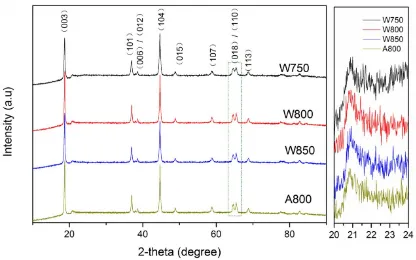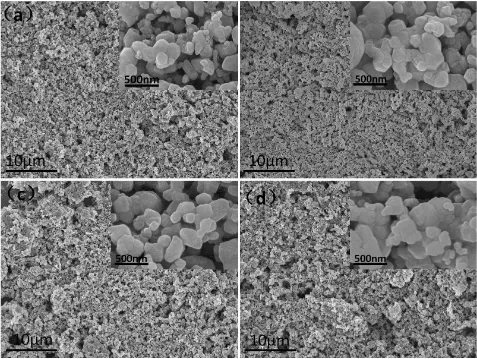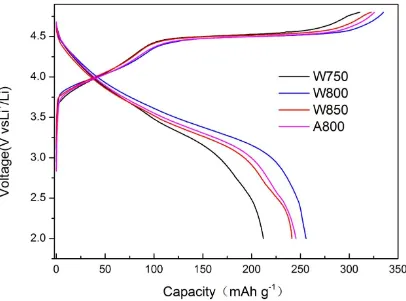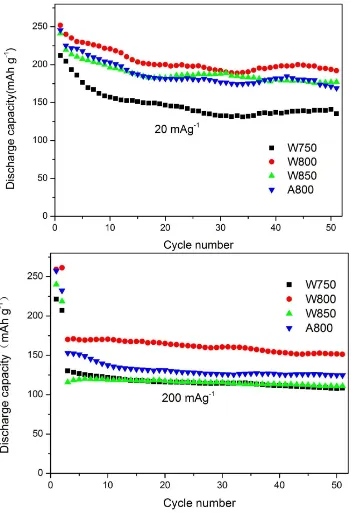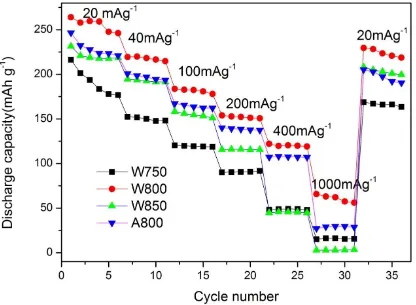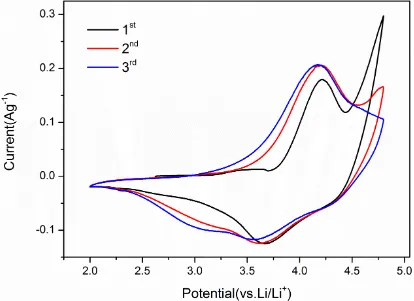Int. J. Electrochem. Sci., 12 (2017) 455 – 465, doi: 10.20964/2017.01.18
International Journal of
ELECTROCHEMICAL
SCIENCE
www.electrochemsci.org
Sol-Gel Combustion Synthesis of Li
1.2Mn
0.54Ni
0.13Co
0.13O
2as
Cathode Materials for Lithium Ion Batteries
Dingzeng He, Qixun Guo*, Hao Yin, Juntao Li, Zhengliang Gong College of Energy, Xiamen University, Xiamen 361005, P.R. China *E-mail: qxguo@xmu.edu.cn
Received: 8 September 2016 / Accepted: 11 November 2016 / Published: 12 December 2016
Nanocrystalline Li[Li0.2Mn0.54Ni0.13Co0.13]O2 cathode materials are successfully prepared by sol-gel combustion method with urea as both chelating agent and fuel. The effects of calcining temperature and solvent on the electrochemical performance are studied. The as prepared samples are characterized and tested by means of XRD, SEM and electrochemical methods. The electrochemical tests indicate that the materials synthesized at 800°C with water solvent deliver a high initial discharge capacity of 255.8 mAhg−1, and a capacity retention of 76.8% after 50 cycles at a current density of 20 mAg-1 between 2.0 and 4.8 V vs. Li/Li+. It also shows better rate capability compared with the materials calcined at 750°C, 850°C as well as the materials using alcohol solvent calcined at 800°C. The experimental results show that enhanced electrochemical performance of the materials calcined at 800°C with water solvent is due to the uniformly distributed nanoparticles with a shorter diffusion path, perfect crystallinity, and ordered layered structure including less cations mixing.
Keywords: Li-rich layered oxide, Sol-gel combustion, Lithium-ion batteries, Cathode materials
1. INTRODUCTION
drawn our much attention on account of their high discharge capacity (230–300mAh g−1) and moderate average discharge voltage (above 3.6 V). [8, 9] It has been testified that the high discharge capacity of LLOs is due to the activation and concurrently transformation of Li2MnO3 component into another active component manganese dioxide (MnO2) when the LLOs electrodes are charged to 4.5 V or higher. What’s more, the product MnO2 could be considered as a structural stabilizer to strengthen the cycling stability of another component LiMO2 even at a wide-voltage window (e.g. 2~4.8 V). [10]
Moreover, electrochemical property of cathode materials validly rely on their particle size and morphology. [11] The cathode materials with nanoscaled particles demonstrated an enhanced rate capability because of large specific surface area. [12, 13] Concurrently, the synthesis approaches will greatly influence the particle size and morphology. At present, many methods have been applied to synthesize xLi2MnO3·(1-x)LiMO2, such as co-precipitation [14], microwave heating [15],sol-gel [16], ion-exchange reaction [17] and solid reaction [18]. In addition, combustion method has already been successfully applied to synthesize cathode materials with the fuel of sucrose [19], urea [20], PVA [21], citric acid [22], gelatin [23] and so on [24]. The Li-rich cathode material Li1.2Mn0.54Ni0.13Co0.13O2 was usually synthesized by co-precipitation [25, 26],but seldom reported by other methods. The method of sol-gel combustion aims at combining sol-gel process with low temperature combustion, which is a simple, cost-effective approach of producing Li1.2Mn0.54Ni0.13Co0.13O2 with short preparation period as well as precise controlling of chemical reation ratios and reaction conditions. The urea can be acted as fuel and chelating agent for sol-gel combustion synthesis to produce submicron particles due to the quantity of heat generated at low temperature and the dispersion of the crystal nucleus while suppressing crystal growth at the same time. In the present work, we used simple sol-gel combustion synthesis to prepareLi1.2Mn0.54Ni0.13Co0.13O2 with good cycling property and excellent rate capability as a cathode material for lithium-ion batteries. We study the structural characteristics and electrochemical properties of Li1.2Mn0.54Ni0.13Co0.13O2 prepared at different temperature and with different solvent. As far as we know, this is the first report that explains the sol-gel combustion synthesis factor of a Li-rich Li[Li0.2Mn0.54Ni0.13Co0.13]O2 layered cathode material.
2. EXPERIMENTAL
2.1. Sample Preparation and Characterization.
Li1.2Mn0.54Ni0.13Co0.13O2 nanoparticles were also prepared using the same procedure with alcohol as solvent and renamed as A800 in simplified form.
The morphologies of the synthesized powder were investigated by field-emission scanning electron microscopy (FESEM) on a Zeiss Supra 55 operated at 10 kV. Powder XRD patterns of each sample were collected in a Rigaku D/Max-IV X-ray diffractometer using Cu Kα radiation operated at 40 kV and 40 mA. Data were recorded at a scan rate of 10°/min, in the 2θ range from 10° to 90°.
2.2. Electrochemical Measurements.
The electrochemical measurements were performed using CR2025 coin-type cells. The electrodes were prepared by coating a slurry, which were containing 80% synthesized materials, 10% carbon black (BLACK PEARL 2000) used for conductive agent, 10% polyvinylidene fluoride (PVDF) as binder mixed in an N-methyl-2-pyrrolidone (NMP) solvent, onto an aluminum foil and dried in vacuum for 12 h at 100 °C. The CR2025 coin-type cells were assembled in Argon-filled glove box (Labmaster100, Mbraun, Germany) with the cathodes as-prepared, metallic lithium foil as counter electrode, Cellgard 2300 film as separator and 1M LiPF6 dissolved in ethyl carbonate (EC) and dimethyl carbonate (DMC) (1:1 in volume) as electrolyte. The charge-discharge experiments were performed galvanostatically between 2.0 and 4.8V on a Land-CT2001 A battery tester (Wuhan, China) at 30 °C. The CR2025 cells were measured at various C rates (0.1, 0.2, 0.5, 1.0, 2.0 and 5.0 C) to investigate the rate capability of the synthesized materials (1 C rate corresponding to 200mAg−1). The cyclic voltammograms were tested by coin cell on a CHI660D electrochemical workstation at a scanning rate of 0.1 mVs−1 with the voltage ranging from 2.0 V to 4.8 V.
3. RESULTS AND DISCUSSION
[image:4.596.91.507.214.474.2]
I(003)/I(104) are 1.22 and1.26, respectively, higher than the intensity ratios for the other samples (such as 0.95 and 1.09 for W750 and W850), indicating that the less disordering of the structure of materials calcinated at 800°C. The ratio of I(003)/I(104) is similar for W800 and A800, indicating that the solvent has no significant influence on the ordering of the structure. Hence, the calcination temperatures applied during sol-gel combustion synthesis progress play an more important role in preparing materials with well-crystallized layered structures. What’s more, the particle size is W750<A800<W800<W850 in order, calculated by the Scherrer formula.
Figure 1. XRD patterns of the four Li1.2Mn0.54Ni0.13Co0.13O2 samples: W750, W800, W850, A800 and the enlarging pictures of the XRD patterns from 20º to 24º.
Figure 2. SEM images of the four Li1.2Mn0.54Ni0.13Co0.13O2 samples: (a)W750, (b)W800, (c)W850, (d)A800, corresponding magnification factor is 2.27k and the embedded pictures in (a), (b), (c),(d) corresponding magnification factor is 59.97k.
[image:5.596.69.546.76.435.2]
Figure 3. the initial charge/discharge curves of the four Li1.2Mn0.54Ni0.13Co0.13O2 samples: W750, W800, W850, A800.
[image:6.596.97.503.67.368.2]
Figure 4. Cycle property of the four Li1.2Mn0.54Ni0.13Co0.13O2 samples: W750, W800, W850, A800 at different current densities.
[image:7.596.126.477.67.580.2]
have more significant influence on the rate performance of the samples, relative to the solvent. It should be noted that the poor rate capability of W750 and W850 is related to the cation mixing in the Li-layers, the poor crystallinity of W750, and the large particles and aggregation of W850. For lithium-rich material, small particles will short the diffusion path of lithium and electron and benefit to the electrochemical properties. A great extent of cations mixed in the layered cathode materials suggests more cations in the Li layer, which could impede lithium transport and result in poor rate properties and poor cyclability. As a whole, the nature conductivity of Li-rich layered oxide is poor, and the transformation from xLi2MnO3·(1-x)LiMO2 to LixMO2(M=Mn,Co,Ni) will mess the well-formed lattice, resulted in low lithium transport.[32]. At the same time, this is the direction of our later research. At different rates, the difference of capacity between the samples is about 80 mAhg-1, which suggests 800℃, in water, is effective to sol-gel combustion synthesize Li-rich layered cathode materials with high rate performance.
Figure 5. Rate performance of the four Li1.2Mn0.54Ni0.13Co0.13O2 samples: W750, W800, W850, A800,the half cells were charged and discharged at the same current densities.
[image:8.596.94.510.286.591.2]
anodic peak over 4.5 V in the initial CV cycle. There are two obvious cathodic peaks in the discharge process. Although it is unlikely to distinguish the reduction courses of the individual Co, Mn and Ni from the curve, it can be supposed from the theoretical analysis that the course at approximate 4.5 V may be contacted with the possession of tetrahedral sites by lithium in the wide delithiated layer and the lower voltage processed at about 3.25 V to the possession of octahedral sites, consistent with the studies of Hayley et al [34]. The two courses still arise at the third cycle, and the conclusion that both of the reaction processes are reversible can be testified.
Figure 6. Cyclic voltammetry curves of the Li1.2Mn0.54Ni0.13Co0.13O2 sample of W800 for the initial three cycles (the scan rate is 0.1mV s-1 and voltage range is 2-4.8V)
4. CONCLUSIONS
[image:9.596.92.506.203.504.2]
electrochemical properties. Overall, the results obtained suggest that both solvent and calcining temperature, especially the calcining temperature play important roles in the synthesis of Li1.2Mn0.54Ni0.13Co0.13O2. Suitable calcining temperature and solvent effectively improved the electrochemical property properties of the Li1.2Mn0.54Ni0.13Co0.13O2 synthesized by sol-gel combustion. The materials prepared by sol-gel combustion method are promising cathode materials for rechargeable lithium ion batteries. In the paper, we found the optimum condition for sol-gel combustion synthesis Li1.2Mn0.54Ni0.13Co0.13O2. Then the following research will be devoted to further improve the rate capability and cycle stability.
ACKNOWLEDGMENTS
The project is sponsored by the Scientific Research Foundation for the Returned Overseas Chinese Scholars, State Education Ministry (Batch No. 44) and the Natural Science Foundation of Fujian Province (No.2010J05034).
References
1. X.Y. Lai, J.E. Halpert, and D. Wang, Energy. Environ. Sci., 5 (2012) 5604. 2. B. Kang, and G. Ceder, Nature., 458 (2009) 190.
3. D.D. M. Neil, Z. Lu, and J.R. Dahn, J. Electrochem. Soc., 149 (2002) 1332
4. K. Mizushima, P.C. Jones, P.J. Wiseman, and J.B. Goodenough, Mater.Res. Bull., 15 (1980) 783. 5. K.K. Lee, W.S. Yoon, K.B. Kim, K.Y. Lee, and S.T. Hong, J. Power Sources., 97 (2001) 308. 6. S.B. Majumder, S. Neito, and R.S. Katiyar, J. Power Sources., 154 (2006) 262.
7. J.N. Reimers, E. Rossen, C.D. Jones, and J.R. Dahn, Solid State Ionics., 61 (1993) 335. 8. H.J. Yu, and H.S. Zhou, and J. Phys. Chem. Lett., 4 (2013) 1268.
9. Y. Bai, Y. Li, Y.X. Zhong, S. Chen, and F. Wu, C. Wu, Prog. Chem., 26 (2014) 259.
10.C.H. Zhao, X.X. Liu, X.R. Liu, H. Zhang, and Q. Shen, ACS Appl. Mater.Interfaces., 6 (2014) 2386.
11.C.X. Cheng, L. Tan, H.W. Liu, and X.T. Huang, Mater. Res. Bull., 46 (2011) 2032.
12.J.M. Amarilla, R.M. Rojas, F. Pico, L. Pascual, K. Petrov, D. Kovacheva, M.G. Lazarraga, I. Lejona, and J.M. Rojo, J. Power Sources., 174 (2007) 1212.
13.D. Kovacheva, H. Gadjov, K. Petrov, S. Mandal, M.G. Lazarraga, L. Pascual, J.M. Amarilla, R.M. Rojas, P. Herrero, and J.M. Rojo, J. Mater. Chem., 12 (2002) 1184.
14.B. Li, Y.Y. Yu, J.B. Zhao, J. Power Sources., 275 (2015) 64.
15.Q.W. Peng, Z.Y. Tang, L.Q. Zhang, and X.J. Liu, Mater. Res. Bull., 44 (2009) 2147. 16.S. Sivaprakash, and S.B. Majumder, Solid State Ionics., 181 (2010) 730.
17.D. Kim, S.H. Kang, M. Balasubramanian, and C.S. Johnson, Electrochem. Commun., 12 (2010) 1618.
18.S.J. Shi, J.P. Tu, Y.Y. Tang, Y.X. Yu, Y.Q. Zhang, and X.L. Wang, J. Power Sources .,221 (2013) 300.
19.J.M. Zheng, X.B. Wu, Y. Yang, Electrochimica. Acta., 56 (2011) 3071.
20.C.H. Zhao, Z.B. Hu, Z.H. Qiu, and K.Y. Liu, Micro & Nano Letters., 10 (2015) 662. 21.A. Subramania, N. Angayarkanni, and T. Vasudevan, Mater. Chem. Phys., 102 (2007) 19 22.P. Ghosh, S. Mahanty, R.N. Basu, and Mater. Chem. Phys., 110 (2008) 406.
23.P. Periasamy, and N. Kalaiselvi, J. Power Sources., 159 (2006) 1360.
25.X.J. Guo, Y.X. Li, M. Zheng, J.M. Zheng, J. Li, Z.L. Gong, and Y. Yang, J. Power Sources., 184 (2008) 414.
26.C.S. Johnson, N. Li, C. Lefief, M.M. Thackeray, Electrochem. Commun., 9 (2007) 787.
27.K.A. Jarvis, Z. Deng, L.F. Allard, A. Manthiram, and P.J. Ferreira, Chem. Mater., 22(2012) 11550. 28.Z.L. Gong, H.S. Liu, X.J. Guo, Z.R. Zhang, and Y. Yang, J. Power Sources., 136 (2004) 139. 29.H.Z. Zhang, Q.Q. Qiao, G.R. Li, S.H. Ye, and X.P. Gao, J. Mater. Chem., 22 (2012) 13104. 30.A. Ito, D. Li, Y. Sato, M. Arao, M. Watanabe, M. Hatano, H. Horie, and Y. Ohsaw, J. Power
Sources., 195 (2010) 567.
31.J. Park, J.H. Seo, G. Plett, W. Lu, and A.M. Sastry, Electrochem. Solid State Lett., 14 (2011) 14. 32.S.J. Shi, J.P. Tu, Y.Y. Tang, Y.X. Yu, Y.Q. Zhang, X.L. Wang, and C.D. Gu, J. Power Sources., 228
(2013) 14.
33.W. He, J. Qian, Y. Cao, X. Ai, and H. Yang, RSC Advances., 2 (2012) 3423.
34.H.H. Hayley, N. Yabuuchi, Y.S. Meng, S. Kumar, J. Breger, C.P. Grey, and Y. S. Horn, Chem. Mater.,19 (2007) 2551.
